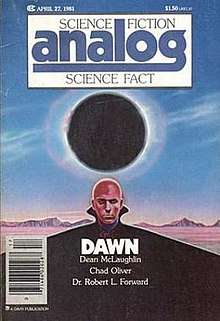Dawn (McLaughlin novel)
Dawn is a science fiction novel by American writer Dean McLaughlin. A re-imagining of Isaac Asimov's 1941 short story "Nightfall", it was serialized in Analog magazine (April–July 1981), with two cover illustrations, for both its first and last segments. The story was republished in hardcover in 2006.
 First publication in Analog | |
| Author | Dean McLaughlin |
|---|---|
| Cover artist | George Angelini |
| Country | United States |
| Language | English |
| Genre | Science fiction |
| Publisher | Analog & Five Star |
Publication date | April 27, 1981 (mag.) November 15, 2006 (hc) |
| Media type | Magazine serial & Hardcover |
| Pages | 307 (hc) |
| ISBN | 978-1-59414-350-2 |
| OCLC | 70673204 |
| 813/.6 22 | |
| LC Class | PS3563.A31794 D39 2006 |
Background
Dawn is set on a world with six or seven "gods" — "Blazing Alpher", "Red Bethe", "Actinic Gamow", "Bright Dalton", "Gold Ephron", and "Embrous Zwicky"; and also "The Pale One", which is the largest but dimmest, and variable in color. There is always at least one of the suns in the sky, so there is no place that experiences nightfall; the only truly dark places are in enclosed spaces such as caves or windowless rooms.
The passings of Alpher from east to west across the sky are the primary units of time, but longer periods are marked by the seasonal shift of Alpher north and south, and the overtaking of one god by another, and sand glasses are used for shorter periods. With two important suns in the sky, the ability to predict their movements would be very valuable to predict conditions over future growing seasons. Alas, while the priests can make useful short-term predictions, over the long term the gods seem to go where they will. The world is a roughly medieval stage of development. The priests of the Temple hold all political power.
Isak is a young scribe with little formal training as a scholar, but he learned of the discovery that a pendulum can be used as a means of accurately measuring extended periods of time, such as from one rising of a sun to its next rising. With this ability, and knowledge gained from his extensive travels about the world, Isak developed the ability to measure the various cycles of the suns, and a theory to explain them. He has used his theory to calculate accurate, long-term foretellings of the movements of the gods, and has seemingly discovered an unprecedented event: a time will soon come when Gamow overtakes the Pale One and passes directly behind the Pale One so his light is blocked. This will happen at a time when they are the only two in the sky, leaving the world below without sunlight. The overtaking will last more than half a passing, long enough that the whole world will experience the darkness.
Plot summary
Isak has attempted to explain his foretelling to the priests of the Temple of Center, so that people might be told what to expect, and not to panic when it does. They are unwilling to accept such a bizarre idea. Furthermore, while Isak is innocent of the political implications of the event he describes, the priests are not. If the gods all turn their sight from the world, they must be angry with their representatives.
Situation
Isak's world has no name, since its inhabitants haven't conceived that there could be anywhere else. In fact, their world is a planet in a multiple-star system. Within that system, the planet orbits around Alpher, a yellow star like Earth's sun. Alpher and the smaller, cooler Bethe form a binary system, orbiting around each other but always separated by distances much greater than the orbit of the planet. The Pale One is either a large moon or a double planet. The other four stars are much farther away from Alpher than Bethe, and spread around Alpher so that evidently there is no place on the planet where all are below the horizon. Gamow and Dalton each orbit by themselves, while Ephron and Zwicky are another binary system. Gamow is well north of the equator, while Dalton and "the Twinned Ones" are well to the south. The orbits of the moon and stars are sufficiently inclined that the inhabitants of the planet have seldom seen an eclipse or occultation.
McLaughlin pays homage to Asimov by naming the protagonist "Isak" and naming a historical figure Duke "Lagash", the name of the planet in "Nightfall". While Asimov simply used the Greek letters Alpha, Beta, Gamma, etc. to name the stars in his story, McLaughlin named his stars Alpher, Bethe, Gamow, Dalton, Ephron, and Zwicky. The first three are an allusion to the famous Alpha-Beta-Gamma paper written in 1948 by Ralph Alpher and George Gamow with Hans Bethe. Dalton and Zwicky are also famous scientists.
See also
References
- Dawn title listing at the Internet Speculative Fiction Database